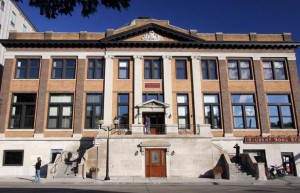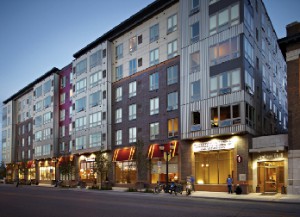Share This
Related Posts
Tags
Doran Companies
By Cutright Elizabeth on Jan 20, 2016 in People
Doran Companies exploded onto the student-housing scene with an audacious plan to provide luxury housing to students attending the University of Minnesota. Breaking ground at the start of the real estate recession was a bold move that paid off.
The company’s current property portfolio at one point included 5 major complexes with 900 units and close to1500 bedrooms: all similarly upscale and all near in or around the University District.

The Dinkydome was a University of Minnesota landmark build from 1913 to 1918 is a unique symbol in one of America’s iconic college neighborhoods, and has undergone a complete renovation.
As founder and principal, Kelly Doran soon realized the needs and wants of the average college student were shifting as increasing numbers chose to move out and live on or near campus.
Doran anticipated the demand for a new type of student housing, and over the years, he has managed to win awards and praise from residents, the University, and industry leaders for his modern, stylish student housing developments.
Gone are the wretched studios and bodies packed into small square-footage most of us remember from our college years. These days, many students are cracking books in stylish, modern apartment complexes that often contain game rooms, study lounges, fitness centers and even tanning booths.
In what is being called a “university housing renaissance,” the high-end student housing trend has carved a lucrative niche in the hyperlocal and hypercompetitive student rental market. With 25% of college students living on or near campus, there’s plenty of demand to push developers into finding new ways to entice tenants.
Leading the charge is Kelly Doran, founder and principal of Doran Companies. This family-owned business manages the development and management of a variety of multi-family residential and commercial properties in its home state of Minnesota. With a focus on aesthetics and quality construction, Doran Companies controls a vast cache of award-winning projects, including its student housing properties located near the University of Minnesota.

Sydney Hall’s 125 unit-mix of studio, one-bedroom, and two-bedroom units and the Dinkydome’s 16 uniquely designed lofts have features such as stainless steel appliances and spacious living rooms.
Doran entered the student housing with a splash. One of the company’s first projects, Sydney Hall, won Best Multifamily and Best Overall for the Business Journal‘s “Best in Real Estate” competition the year it debuted. The project broke ground on a rainy August morning in 2009, just as the national real estate market began its slide into recession. It was a risky move that paid off: In the subsequent 6 years, Doran’s been recognized as a visionary who anticipated – and perhaps even ignited – the current trend of luxury student housing.
Named after his then 8-year-old daughter, who used her pink shovel to toss the first spade of dirt at the ceremonial groundbreaking, Sydney Hall was unlike anything the Twin Cities had seen before. Along with Dinkydome Lofts, Sydney Hall –voted “Best Apartment Complex” by the University of Minnesota students the year it debuted – introduced unparalleled luxury and convenience its college residents.
The Hall’s 125 units are a mix of studios and 1-2 bedroom apartments. Often fully furnished and outfitted with stainless steel appliances, Sydney Hall renters can expect to have their every need catered to via a whole host of amenities, like movie theaters, yoga studios, and rooftop entertainment areas. And because Sydney Hall is centrally located, tenants need only walk or bike a few blocks to attend classes or bank time at the University library.
As Doran explained to the Star Tribune in a 2014 interview, a few years ago he began to notice that the type of students attending the University of Minnesota had changed. He understood transformation would result in new student-housing expectations and demands. Forty years ago, only a quarter of University of Minnesota students lived on or near campus, but Doran estimates that number has grown to 60 percent. He could see this explosion of onsite residencies would result in an increased need for near-campus housing.
“When I went to the U back in the late ’70s and early ’80s, if you could fog a mirror you could get in,” Doran told the Star Tribune. “Now it’s a school of first choice. Now with its higher admission standards, when the kids go there, they want to have that college experience. They don’t want to live at home.”
While some may fear these pricier complexes will push needier students out of the market, in truth the increased vacancies are a win-win for all involved. For the communities that host these developments, property tax revenue increases. For Universities, commuting students can be convinced to ditch their cars and live in closer proximity to campus, cutting down on parking and transportation needs.
Maybe even more importantly, the ability of students to choose from more housing units creates a more competitive marketplace and lower rents overall. In fact, the Twin Cities Daily Planet studied four student neighborhoods who had recently added luxury student housing to determine the impact these types of apartment complexes might have on unit price and occupancy. Ultimately, their data indicated “the new student housing projects and the youth that live in them actually lower the rent cost for other students, making living near campus more affordable on average.”
Assessing the Future
With over 30 years of experience in the real estate development business, Kelly Doran constantly casts his savvy gaze across the commercial and residential landscape, ready to seize the next big opportunity but wary of making assumptions.
“I’ve always been one who’s reluctant to make generalized statements about markets because that’s not how development works,” Doran told Twin Cities Business.
“Development is a case-by-case scenario,” he continues. “The overall market may be softening, but that doesn’t mean that there’s not an opportunity at a select location to build a multifamily project.”
